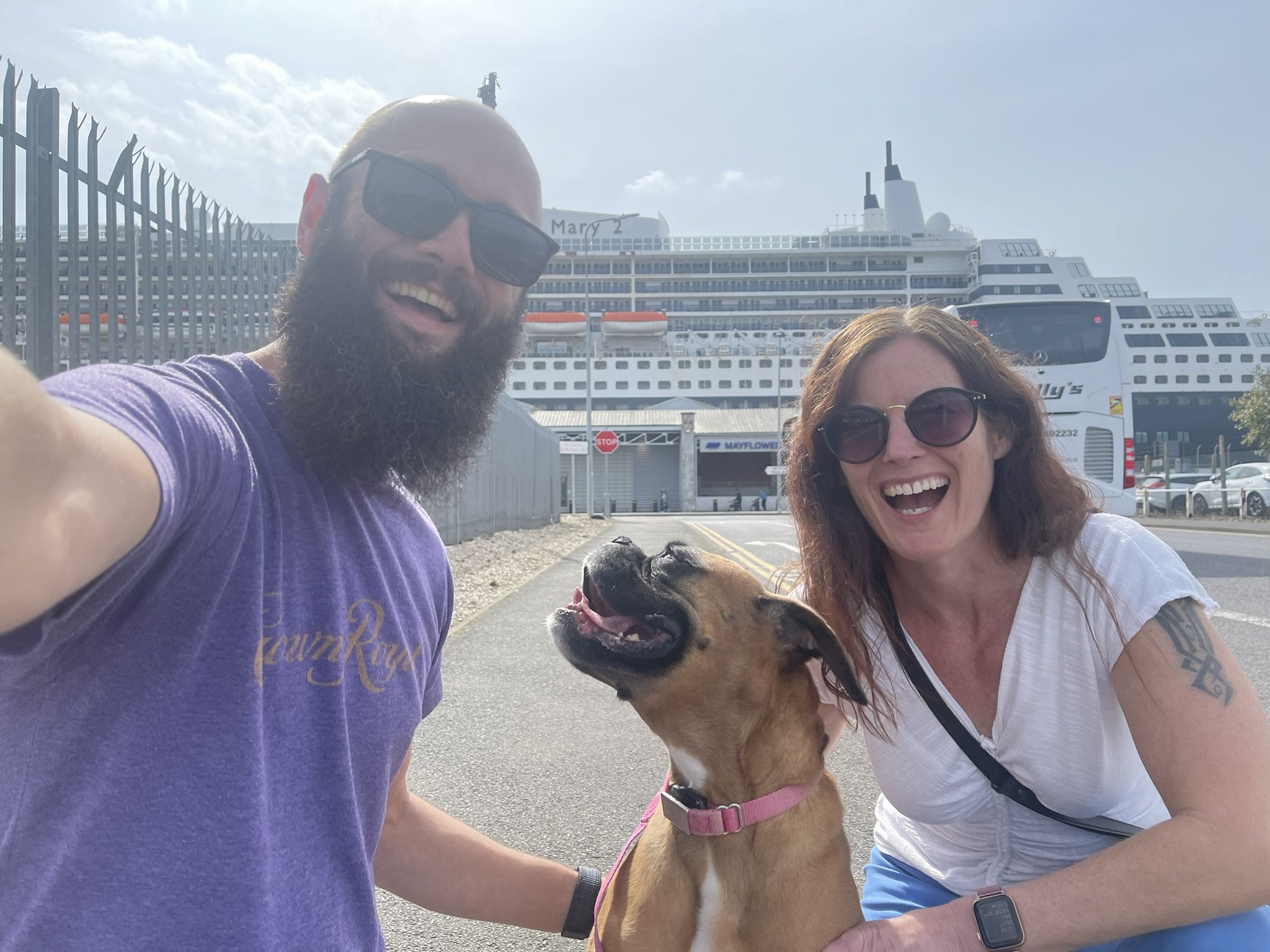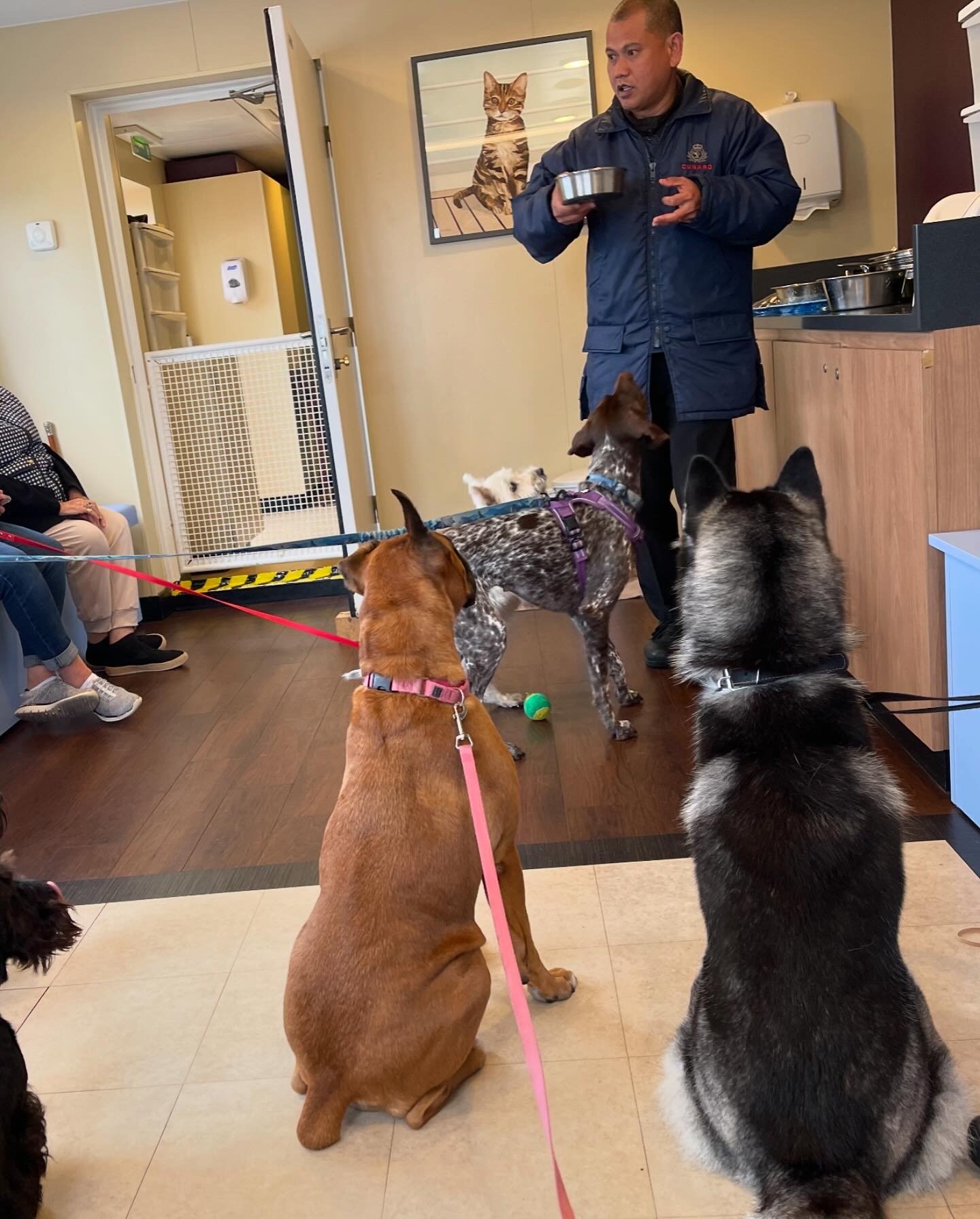Moving my Boxer dog overseas while serving in the military
Picture day with Oliver and John
Us right before boarding Queen Mary 2
In October of 2021, I received the opportunity of a lifetime to get stationed overseas working for NATO. I was supposed to be so excited—the chance to serve in Europe with a job promising adventure and travel. Instead, although I was excited, I was also fraught with worry and apprehension—not about the dynamic assignment that carried such a global impact but about moving my Boxer dog.
Of my 28 years in the service, coordinating her travel was the hardest parts of any prior move and easily the most stressful. However, here’s how I did it and the article I wished I’d read prior to doing so.
Sure, moving always comes with lots of stress, but nothing prepared my husband and I for how difficult it was to move a snub-nosed breed during the summer months overseas. Nothing about taking on this new assignment took us more time to work out than figuring out how we could safely get our cherished furry family member to our next duty destination.
Many people opt to put their large dogs in the belly of the aircraft, commonly referred to as the cargo hold. We didn’t fully trust that option; however, as there are always risks when a plane is delayed sitting on the runway, and beyond that, while rare there have tragically been a few dogs that perished while airborne due to improper cargo temperatures.
Furthermore, our anxious Boxer girl Jayda would not take to being separated from us in a noisy cabin hold for approximately 14 hours of traveling with two flights. Lastly, even if we wanted to fly her on an airplane in the cargo hold, due to snub-nosed airline blackouts, we would have spent thousands of dollars leaving Harry behind in Norfolk to travel later or forced to spend thousands of dollars kenneling her until the outside temperature cooled.
We explored private charter jet options, but we did not want to spend 8-12k for just one of us and our dog. Ultimately, we made a tough and time-consuming decision. My husband decided to train Jayda as a service dog, ensuring she could legitimately perform the tasks assigned and safely move through an airport and in an aircraft cabin.
I want to caveat that the service dog option was not a decision we took lightly. Jayda received nearly a year of training with my husband, bringing her to as many public places as possible, including nightly walks at Home Depot dropping large objects near her to help her feel safe in public and in loud settings. This intensive training was the only way we felt comfortable pursuing this path. We also hired a dog behaviorist who made Jayda more comfortable at restaurants, riding in the car, and moving through crowds.
Jayda calmly watching the other passengers right after boarding
Jayda additionally tested as a Canine Good Citizen, which, although not required, gave us the confidence that she was ready for the flight. We concluded her training by consulting with a medical professional who officially certified Jayda as a functioning psychiatric service dog. This preparation ensured we completed every step of the custom import requirements for transporting a service dog into the Heathrow Animal Control Center.
We even considered putting her on the Queen Mary 2 at the time. Unfortunately, we hit a major roadblock. The Queen Mary 2’s kennels are booked 24 months in advance, so a transatlantic ship ride was not an option when we found out I had the chance to serve in London—or so I thought (more on this later).
As we discussed how to return Jayda to the United States two years later, we decided to let Jayda take a break and move her as a pet on a cruise ship. We wanted the freedom to enjoy the journey without having to take her everywhere without her on duty besides us.
The option of a transatlantic crossing was a lot of work to plan and required endless research, for which my husband deserves all the credit. In this blog, I will summarize the top considerations that helped us plan this trip and what we learned along the way.
Hopefully, this will help you decide if a transatlantic crossing is an option for you.
Oliver the kennelmaster who has been there 14 years feeds the dogs in the visitor area. Him and his assistant John took great care of us.
Jayda made lots of friends while onboard. Here she is with Truffle.
Inside the kennels
Book early! Pet kennels are open for booking two years in advance. There are transatlantic crossings almost every month, with a couple of months that have two. The two main stops on each end are NYC and Southampton. When we booked, it cost 1k to book a pet kennel. If you have a legitimate service dog, you can bring the dog without the extra fee. Your dog will remain with you at all times and be in a working status.
You can make multiple deposits for bookings. There is a waitlist after the kennels get booked. Cruisers have up to 120 days out to get a refundable deposit returned should they choose not to make the crossing. A kennel spot is then opened. We got called for at least two other bookings we made beyond the one we eventually took, so spots do open even if you are further down on the waitlist. For example, in July, we were called after being #7 on the list. Unfortunately, due to when my relief at work was arriving, I could not make that crossing. We didn’t know until making this crossing that cancellations happen even less than 120 days out, and you can keep emailing the office that handles the pet bookings if a kennel becomes available.
Embarking and disembarking procedures. To bring a dog or cat onboard, they must be microchipped and have an up-to-date rabies vaccine. Beginning this past August, you must also fill out this CDC import form. We forgot about it, which caused me a panic attack at the cruise terminal until I realized it was automatic, and we received instant approval. The Queen Mary staff will prioritize your boarding before other passengers, but you must show them this form, so do it in advance. You also get to disembark before the other passengers, as we met up on deck 12 before leaving where the kennels are located, then make our way off the ship, disembarking around 8:30 a.m. Overall, on each end, it was a very smooth process.
The accommodations onboard. As I previously mentioned, the kennels are located on deck 12 near the aft of the ship. There is a visitor sitting area with approximately 10-12 people with pets and a walking area forming a semicircle around the upper deck. When the dogs are out of the kennels, the kennel master, Oliver (and his assistant, John) watch everything. In addition to the staff picking up all the poop and mopping up the pee (or as they affectionately called it “007 and code yellow”) on the hardwood decks, they feed all the pets and make sure no non-pet owners trespass the pet area, and no dogs get unruly. Since dogs have such variety in play styles and tolerance levels, they were always closely supervised. There were visiting hours 3x/day, with four hours in the morning, three in the midafternoon, and one hour around the dinner period. During these hours, we often stayed past the walk and got plenty of cuddles and pets with the dogs and a chance to socialize with the other owners in the visiting area. This time with the different dog owners made this cruise unique and memorable!!
Perks of the ship ride. The dogs and their owners were treated like royalty. We received priority boarding and disembarkation. Jayda received a QM2 fleece jacket and a framed certificate for making her first trans-Atlantic crossing, and we received a free 8x10 printed professional print of our group photo with other pet owners. With our free $100 onboard credit due to serving in the military, we could purchase additional images, so we chose two for $60 that we intend to enlarge and frame. Other than socializing with the other dog owners (one couple in particular who live near Harry’s childhood home and who we keep in touch with) throughout the week, numerous passengers gathered daily near the kennels. Everyone seemed to love having us onboard, even the staff working in other parts of the ship would stop by and visit.
Military benefits for travel. If you are traveling OCONUS to CONUS and take even a day of leave enroute, you may qualify for Circuitous travel, which will pay you what the government would have spent on your plane ticket. However, you must let your detailer know in advance you intend to claim this benefit and have it written into your orders. Each service may have different requirements than the Navy, so please get with your administrative staff and see if this works for you. I will post an update later on how this worked when liquidating my travel voucher and filing my claim of up to 2k in pet reimbursement. We had several expenses beyond the ship boarding charge, including a crate, pet hotel fees for hotels which we stopped in from NYC to Gulfport, and other miscellaneous costs.
Harry running Jayda with her QM2 jacket
Overall, these two options for transporting our dog to and from our overseas duty station were a lot of work, but they kept our family traveling together. I hope I have shown that it is possible. Please reach out if there is something I did not answer. Best of luck with your move!
Special thanks to Liz Hensel (Leave No Paws Behind USA), Kari Mendosa (Island Pet Movers) and Danique Masingill (Leashes of Valor) whose tireless counseling and advocacy were key in our understanding of the laws and policies concerning pet travel. This blog is dedicated to them and all the animal warriors who help us keep our pets!









